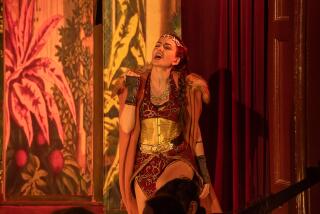Glories of Bach, Vivaldi Explored in Orange
- Share via
When Bach was trying to figure out how to write concertos, he turned to Vivaldi for inspiration. He transcribed at least 10 violin concertos by the Italian master for keyboard to study them as models of structure, modulation and invention. Now, thanks to conductor William Hall, we know Bach was listening--at least with his inner ear--very closely to Vivaldi’s choral music as well. We heard the evidence when the Hall Master Chorale and Chapman University Singers sang Vivaldi’s Gloria and Bach’s Magnificat on Sunday in the Memorial Auditorium at Chapman University in Orange.
The big surprise was how serious and weighty (i.e. Bachian) Vivaldi could sound and how light and Italianate Bach could sound, without significantly changing the quality of these superior works. This was just one of the tricks Hall had up his sleeve. Several of Vivaldi’s choruses in the work (“Et in terra pax” and “Gratias agimus tibi” seemed almost like blueprints for sections of Bach’s B-Minor Mass, down to the rhythms and even the keys, if a non-perfect pitch ear could be trusted. The final chorus, “Cum Sancto Spiritu,” sounded especially rich and glorious, in a Bach-like way.
The Master Chorale is now in residence at the university (where Hall is chairman of the music department), but the roster of singers distinguished between the two groups. Listed were 32 singers for the Chapman contingent and nearly 130 for the chorale. Hall arranged them in six rows, with sopranos and altos flanking tenors and basses (a row of women also framed the singers at the front of the chorus). The result was a full, rich, honed and sustained organ-like sound for the singers.
One might have thought that such a vocal force would overwhelm the 26-member orchestra, but Hall made sure that didn’t happen. The orchestra played crisply and with buoyancy. In fact, Hall proved a master of eliciting lilting rhythms from his instrumentalists, as well as from his singers, and ending sections with suave, even witty cadences. The variety of sonority Hall achieved was another surprise. Hall created more kinds of choral sound than we usually hear in concerts, historically informed or not.
These ranged from massed, yet fluid and full-strength choruses to mysteriously floating and hovering lines (Bach’s “Gloria Patri” and “Suscepit Israel,” respectively), with jolly, dance-like sections in between. The use of embellishments or interpolated notes (trills, triplets and other figures), which is proper performance practice yet almost never done in Bach and rarely in Vivaldi, was another fascinating aspect. Understandably cautious in executing them were the three student soprano soloists: Zoie Lamb (in Vivaldi’s “Domine Deus”), Sara Price (Bach’s “Quia respexit”) and Courtney Taylor (Vivaldi’s “Laudamus te”).
The professionals, mezzo-soprano Debbie Cree Smith, tenor Steven Dunham and bass Louis Lebherz, didn’t necessarily fare much better. Of the instrumentalists, special note must be made of cellist Yao Zhao, harpsichordist Sandra McCune and organist Francis Johnston.
More to Read
The biggest entertainment stories
Get our big stories about Hollywood, film, television, music, arts, culture and more right in your inbox as soon as they publish.
You may occasionally receive promotional content from the Los Angeles Times.










